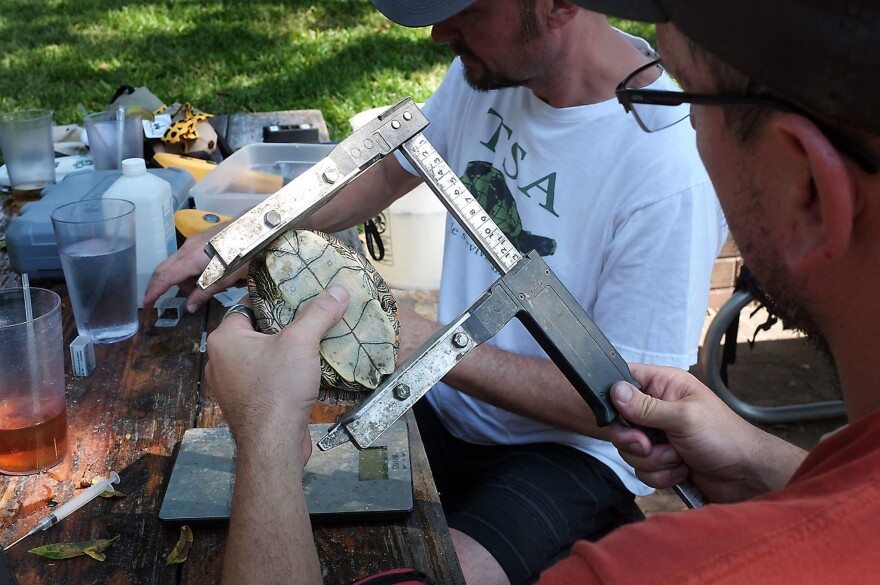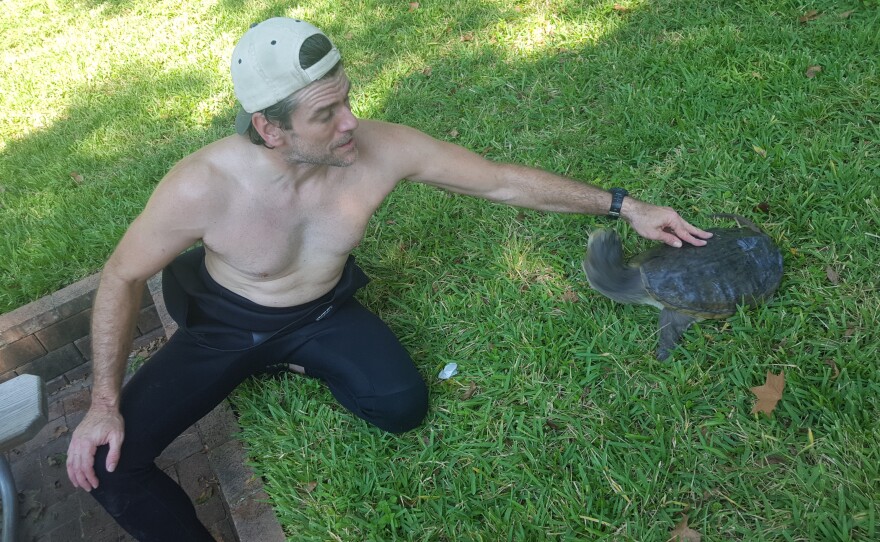An obsession can be dangerous. It can distract you from things that are important in life. But an obsession can also motivate you, to explore, discover and create.
For the last several days a group of men who share a singular obsession with turtles have been swimming in creeks and springs of Central Texas.
By the end of this story three guys get bitten by turtles, and a turtle gets a tattoo. But it begins with Andrew Walde, sitting at a picnic table in Texas and reflecting on his childhood in Northern Ontario, Canada.
“I grew up in a turtleless world. Every time I traveled I got to see turtles, but never at home,” he says. “Here I am 20 years later, leading an international group doing turtle work all over the world.”
On this September day, turtle work has brought him to the County Line Bar-B-Q restaurant on Lake Austin. The restaurant sits along Bull Creek, a creek that's teeming with turtles. Diners often get up from their barbecue, wander down to the dock and throw bread into the water to feed them.

Now, the turtles have attracted Walde and the group of self-described “turtle nerds.” Their mission: to tag and microchip as many of the turtles as they can to track the local population.
“Our goal is long-term monitoring of species that are perceived to be abundant,” says Eric Munscher, head of the North American Freshwater Turtle Research Group, a division of the Survival Alliance.
Carl Franklin, a herpetologist from UT-Arlington who has come down to help, has a different spin on it.
“I’m going to go out on a limb and say that science is a nice crutch for a bunch of useless SOBs to get out and have fun on a workday,” he says.

While Munscher stays on shore, Walde, Franklin and others put on snorkels to scour the creek for turtles. Walde is the first one to get snapped.
“He took a chunk out of me!” he laughs as he hauls a mesh bag full of turtles to the dock.
The divers haul in massive amounts of turtles in from the creek, pouring them into buckets, coolers and little blue recycling bins. The idea is to return here over time to see how the turtle population changes.
“Hopefully, all the data and information and memories and photos and eye candy we record will be available for nerds 100, 200 years down the line,” says Franklin.

They find musk turtles, map turtles, red-eared sliders. But Eric Munscher says one kind eludes them, a Guadalupe Spiny Softshell.
“We don’t catch many,” he says. “They’re just a harder to come by, harder to catch overall because they’re fast. And we saw videos with softshells here which peeked out interest.”
And, just like that, they get one.
“Pretty cool,” says Munscher approvingly. “They actually have a shell. It’s just overlaid with flesh”
Then, the turtle bites Munscher.
Normally, they cut a notch in the shell to mark turtles they’ve microchipped. But, the soft shell of the Guadalupe Spiny presents a problem. A notch would injure them, so they’ve devised another method. They tattoo soft-shelled turtles, a method they practiced on watermelons before applying it in the field.

But, before they get around to breaking out the needle, they haul in a massive snapping turtle.
This time, Franklin gets bit. The snapper looked ready to take a chunk of his wrist, but thanks to his quick reflexes, it was just a grazing nip.
After two hours, the team estimates they’ve caught around 8o turtles. They get to work weighing, measuring and notching the hard shells.
“I think, for them, it’s kind of like when we get our teeth scraped” Franklin says of the notching.
The single Guadalupe Spiny Softshell they caught gets tattooed with the number “1.” Because it’s the first softshell they caught at this site.

In other contexts the tattooing practice has been even more helpful.
“When we were releasing Burmese Star tortoises over in Myanmar, we tattooed their shells,” says Walde. “We put a sign on them which was a religious symbol that meant the forest gnat spirit was protecting them. So that if a local person found them, they wouldn’t try to sell them in the village.”
He says some of the turtles were poached, but the tattoos lead to their recovery and re-release.
As far as the work in Central Texas goes, the group might return as early as next February to check in on the turtles. Until then, if you see a turtle with a tattoo swimming around, you know where it probably came from.
And, please, watch your fingers.







